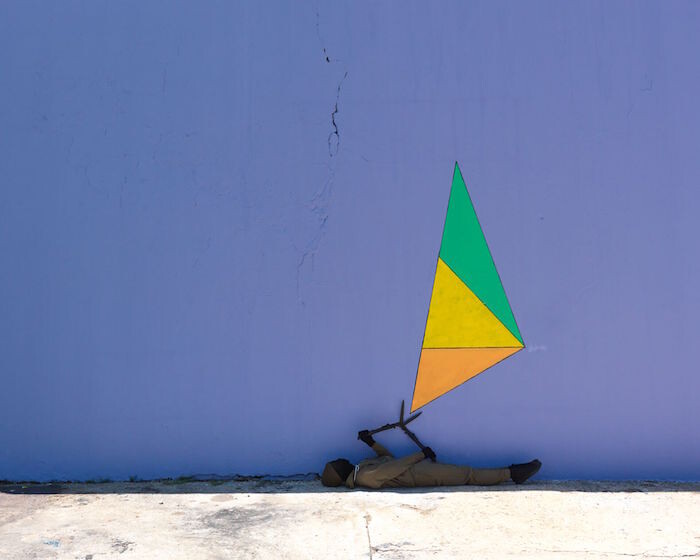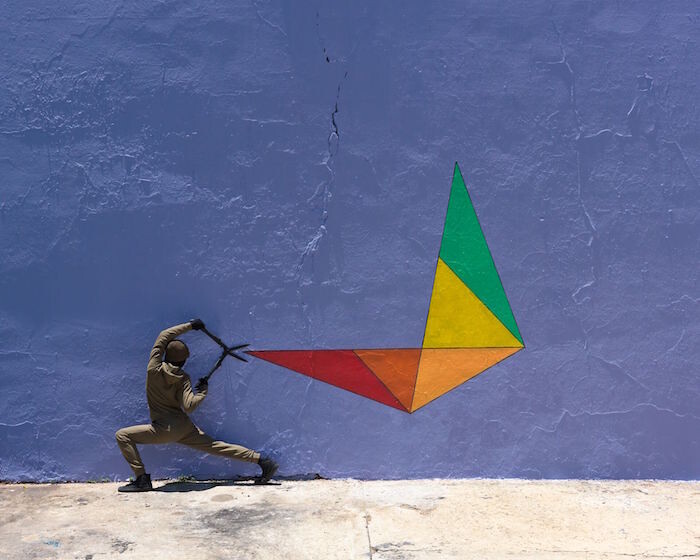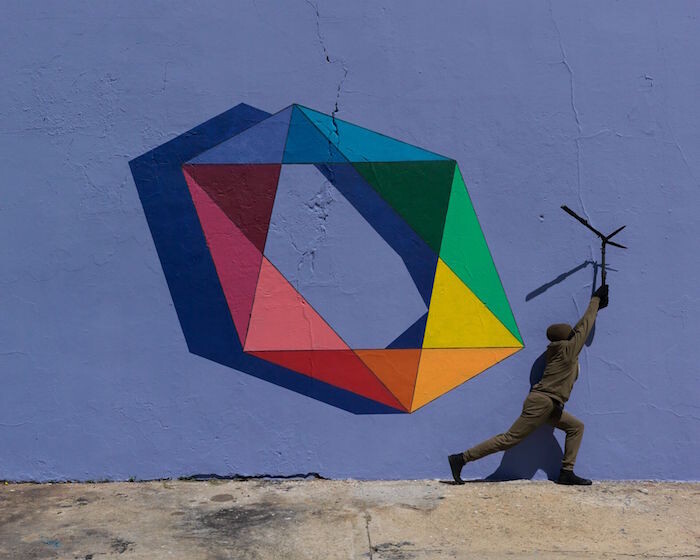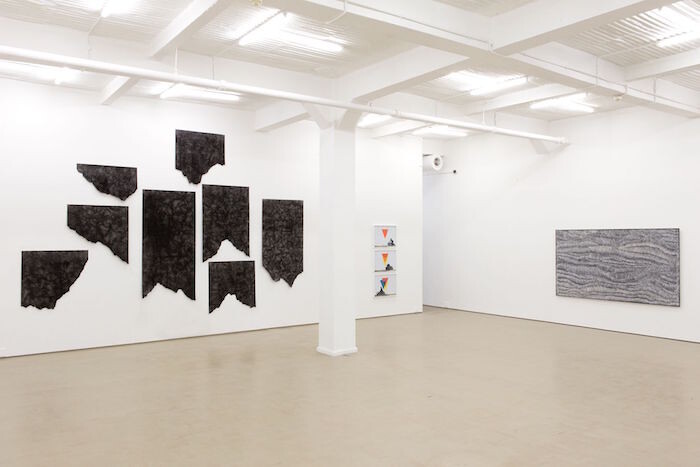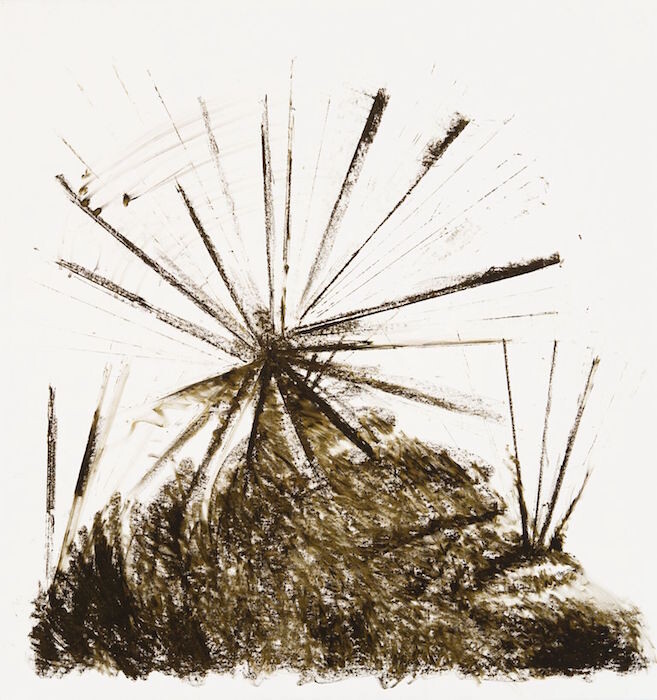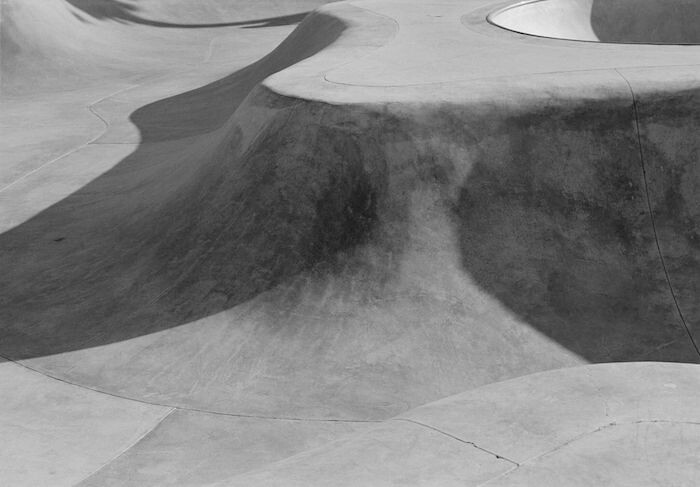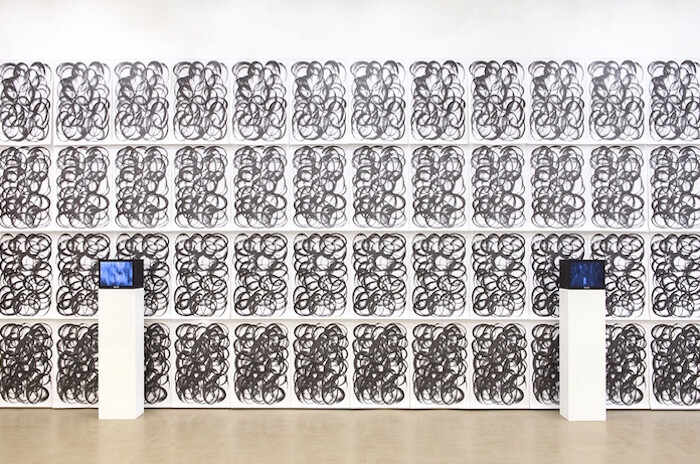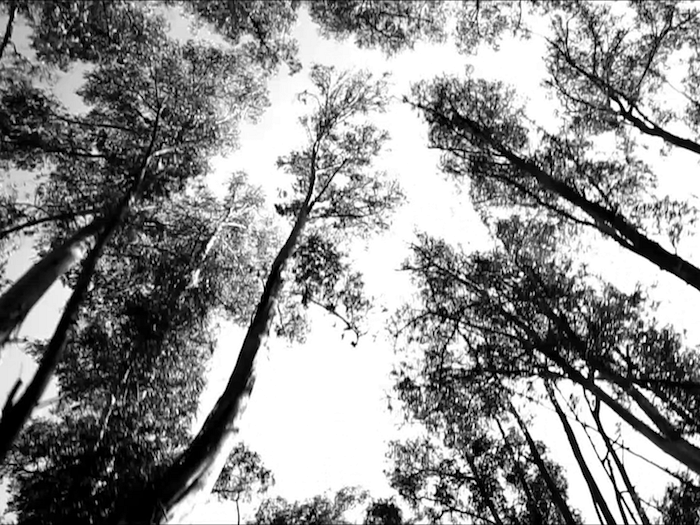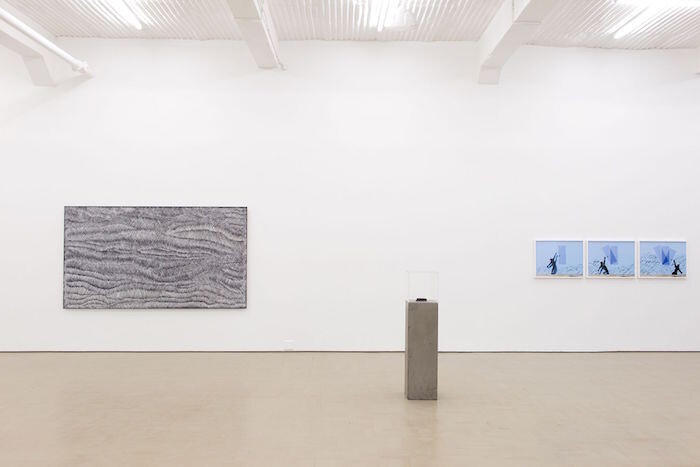Berlin-based Robin Rhode’s third solo exhibition with Stevenson is an accomplished recapitulation of ideas and gestures that have featured in his mature practice since leaving South Africa in the mid-2000s. Rhode’s work is grounded in repetition, notably his Eadweard Muybridge-like photo animations, which here include Paradise (2016) and Inverted Cycle (2016). These sequentially choreographed still performances incrementally explore a concise narrative, here to do with color theory. But when does formal repetition become empty rehearsal? The question lingers in the interstices of this polished show, which is composed of drawings, sculpture, photographs, and films. The loose choreography of the works allows for an episodic encounter, or, to improvise on the show’s title, suggests various paths and routes to an answer.
The atomized form of “Paths and Fields” also offers a flashback to curator Stephanie Rosenthal’s layout of the artist’s 2008 London debut, “Robin Rhode: Who Saw Who” at the Hayward Gallery, a heterogeneous showcase grounded in Rhode’s evolving interests in street culture—notably skateboarding and graffiti—and various postwar avant-gardes. The Hayward show was notable for including early examples of the artist’s abstract paintings and drawings, which here retain their hesitant, gee-whiz quality. Works on White Paper IV (2008), an oil stick drawing of a dense mound topped with windmill-like rotors, resembles the leftover residue of one of Rhode’s wall performances, but is also simply an abstract drawing.
Producing works with propulsive energy from the barest means is one of Rhode’s gifts. LA Skatepark (2012-17) is a photographic description of an empty recreational environment, its curved surfaces abraded and marked through repeated use. The immanent scene, one in which observation rather than intervention is the artist’s only contribution, contrasts with the frustrated stillness of Slalom (2012-17), in which a young man, one of Rhode’s cap-wearing performance doppelgängers, is presented in snow equipment trying to ski on a rocky outcrop. Irony and frustration are coded into Rhode’s practice, which, early on, included live performances in which he interacted with wall-drawn objects. A precursor to his sequential photographs, these early performances sublimated his adolescent experiences of hazing at school into a viable practice.
Rhode’s digital animation The Grass Is Singing (2015), which shares its title with Doris Lessing’s 1950 novel about racial politics in former Rhodesia, is a melancholy study in material lack and mimicry: his costumed doppelgänger plays a violin using an oversized fork and stick against a black wall that gradually fills with growing, rhythmic white lines. The violin solo, played by Martin Weiss, was scored by Berlin composer Arenor Anuku and forms a concise addition to a growing body of animation works produced in collaboration with Anuku. Trees/Earth/Paths and Fields (2016), an installation featuring two black-and-white videos replaying footage of the titular subjects, is grander in scale but less engaging. The installation includes a backdrop of posters with billowing motifs repurposed from Rhode’s ambitious if turgid staging of Arnold Schönberg’s one-act monodrama Erwartung on Times Square for Performa in 2015 (“Arnold Schönberg’s ‘Erwartung’: A Performance by Robin Rhode”).
Rhode’s work has always embraced tonal restraint, perhaps due to his early use of charcoal on white walls. Untitled/Trees (negative) (2016), a nearly two-and-a-half meter abstract drawing made from chalk and acrylic crosshatchings, exemplifies the endurance of this low-key tonal register in his current work. The drawing is likened, in the press release, to Alighiero e Boetti’s ballpoint pen drawings from 1972. The comparison is tenuous, but explicable: “Paths and Fields” is loosely rationalized as an investigation into Rhode’s longstanding interest in the legacy of Arte Povera following a 2005 visit to Castello di Rivoli in Turin. “I have this romantic notion that my exhibitions pay homage to the roaring Seventies of Italian art,” Rhode is quoted. His interest in the spectral legacy of Arte Povera—and the genealogical mapping this involves—is worth parsing.
The idea of an artistic avant-garde, whether mooted as a fragile notion or pitched as viable concept, has long involved South African writers—be they proponents or critics—basing their arguments on a dichotomy between northern tradition and southern circumstance. Writing in the catalogue for the 1997 Johannesburg Biennale, artist David Koloane, a key protagonist in a post-realist tradition of black painting, reiterated this method. After pouring cold water on the idea of an “emergent avant-garde movement” in post-apartheid South Africa, Koloane panned pre-1994 examples as rehearsals of earlier northern-hemisphere experiments. He is right. And yet, in 1995, Moshekwa Langa’s materially impoverished debut exhibition at the former Rembrandt van Rijn Art Gallery in Johannesburg radically shifted the grammar of the post-painterly, announcing a new materiality that Rhode exemplified in his early sculptures from 1998. For a short while his practice seemed sui generis; art history, and indeed Rhode’s own travel itinerary, tamed this interpretive exuberance. While the urgency and innovation may have bleached somewhat in his newer work, Rhode’s practice remains true to its motivating ambition of overcoming difficulty through startling invention. It is just that this drive seems incrementally enacted nowadays.
